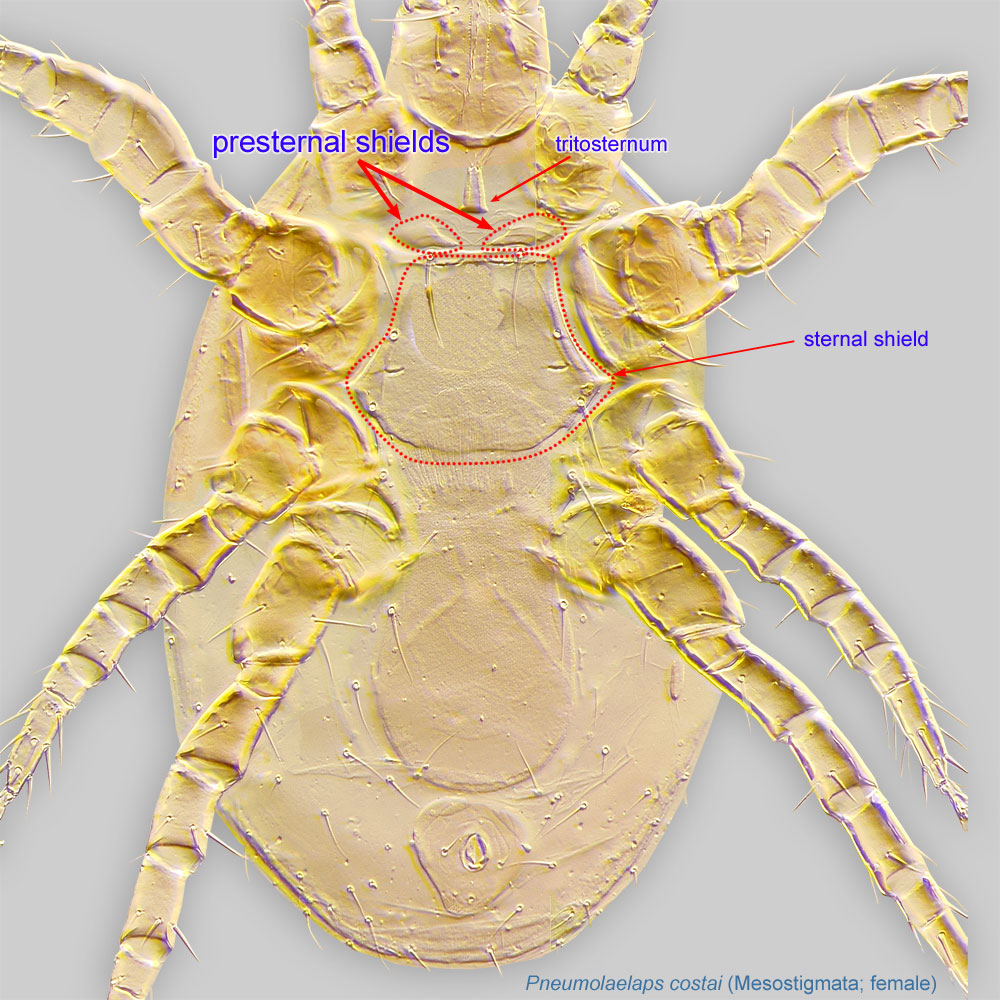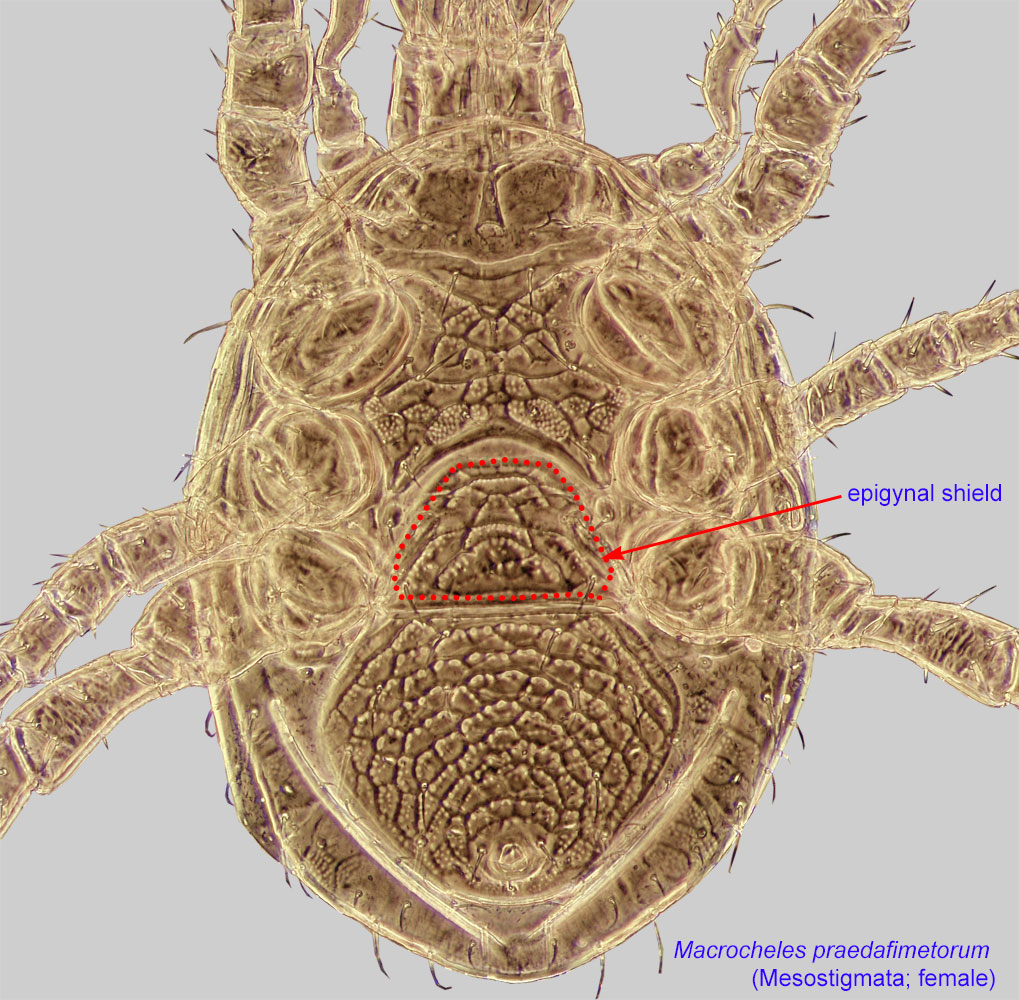kleptoparasitic; feeds on provisioned pollen in brood cells, where it may cause no harm or may reduce fitness of developing bees due to competition for food
Laelaspoides Eickwort, 1966Eickwort, 1966:
Eickwort, G. C. 1966. A new genus and species of mite associated with the green bee Augochlorella (Hymenoptera: Halictidae) in Kansas (Acarina: Laelaptidae: Hypoaspidinae). Journal of the Kansas Entomological Society.39: 410-429.
Superorder Parasitiformes » Order Mesostigmata » Suborder Monogynaspida » Hyporder Dermanyssiae » Family Laelapidae » Genus Laelaspoides
Laelaspoides ordwayae Eickwort, 1966Eickwort, 1966:
Eickwort, G. C. 1966. A new genus and species of mite associated with the green bee Augochlorella (Hymenoptera: Halictidae) in Kansas (Acarina: Laelaptidae: Hypoaspidinae). Journal of the Kansas Entomological Society.39: 410-429.
Female: Presternal shieldsPresternal shield:
Small, paired sclerotized plates anterior to the sternal shield and laterad or posteriad the base of the tritosternum in some Mesostigmata. Also known as presternal platelets.
 fused with sternal shieldsternal shield:
fused with sternal shieldsternal shield:
A shield in the anterior intercoxal region of parasitiform mites that bears one or more pairs of sternal setae.
 (Figs. 2, 3). Some posterior setae finely pilose (Figs. 2, 4).
(Figs. 2, 3). Some posterior setae finely pilose (Figs. 2, 4).
This genus contains a single described species, Laelaspoides ordwayae.
Pneumolaelaps and Hypoaspis sensu Evans and Till (Evans and Till, 1979Evans and Till, 1979:
Evans, G. O. amp; W. M. Till. 1979. Mesostigmatic mites of Britain and Ireland (Chelicerata: Acari-Parasitiformes). An introduction to their external morphology and classification. Transactions of the Zoological Society of London.35: 145-270.).
Laelaspoides can be distinguished from both these genera: its presternal shieldspresternal shield:
Small, paired sclerotized plates anterior to the sternal shield and laterad or posteriad the base of the tritosternum in some Mesostigmata. Also known as presternal platelets.
 are fused with its sternal shieldsternal shield:
are fused with its sternal shieldsternal shield:
A shield in the anterior intercoxal region of parasitiform mites that bears one or more pairs of sternal setae.
 (Figs. 2, 3). In Pneumolaelaps and Hypoaspis presternal shields are not fused with the sternal shieldsternal shield:
(Figs. 2, 3). In Pneumolaelaps and Hypoaspis presternal shields are not fused with the sternal shieldsternal shield:
A shield in the anterior intercoxal region of parasitiform mites that bears one or more pairs of sternal setae.
 .
.
Laelaspoides Eickwort, 1966Eickwort, 1966:
Eickwort, G. C. 1966. A new genus and species of mite associated with the green bee Augochlorella (Hymenoptera: Halictidae) in Kansas (Acarina: Laelaptidae: Hypoaspidinae). Journal of the Kansas Entomological Society.39: 410-429. was synonymized with Pseudoparasitus (Farrier and Hennessey, 1993Farrier and Hennessey, 1993:
Farrier, M. H. amp; M. K. Hennessey. 1993. Soil-inhabiting and free-living Mesostigmata (Acari-Parasitiformes) from North America. An annotated checklist with bibliography and index. North Carolina Agricultural Research Service Technical Bulletin.302: i-xvi, 1-408.) probably because the spelling of the former was confused with a very similar spelling of a different genus, Laelapsoides Willmann, 1952, which is an accepted junior synonym of Pseudoparasitus. Laelaspoides and Pseudoparasitus are strikingly different. For example, in Pseudoparasitus the epigynal shieldepigynal shield:
A shield protecting the female genital opening. Well-developed in Mesostigmata. Also known as epigynial shield.
 has 4 or more pairs of setae while that of Laelaspoides has only one pair.
has 4 or more pairs of setae while that of Laelaspoides has only one pair.
Known from the USA (Eickwort, 1966Eickwort, 1966:
Eickwort, G. C. 1966. A new genus and species of mite associated with the green bee Augochlorella (Hymenoptera: Halictidae) in Kansas (Acarina: Laelaptidae: Hypoaspidinae). Journal of the Kansas Entomological Society.39: 410-429.) and Costa Rica (our data).
halictid bee Augochlorella
permanentpermanent:
associated exclusively with bees or their close relative, wasps; cannot live without these hosts
Biology was described for the single species in the genus, Laelaspoides ordwayae, in Eickwort, 1966Eickwort, 1966:
Eickwort, G. C. 1966. A new genus and species of mite associated with the green bee Augochlorella (Hymenoptera: Halictidae) in Kansas (Acarina: Laelaptidae: Hypoaspidinae). Journal of the Kansas Entomological Society.39: 410-429.. Laelaspoides ordwayae is known from associations with two ground-nesting halictid bees, Augochlorella striata and Augochlorella persimilis, in Kansas. All stages except for larvae are abundant in the nest cells of the bees and are encountered more rarely in the cell cluster cavity of the nests. The larval period is either short, with the larvae molting into protonymphsprotonymph:
Ontogenetic stage between larva and deutonymph. See <a href="index.cfm?pageID=1720">Life stages page</a> for more details.
soon after hatching, or the mite is nymphiparous, passing the larval stage within the female. After hibernation and before the bees start to build nests, the mites disperse on bees via phoresyphoresy:
Attaching to or boarding another organism (i.e., a host) for dispersal to new habitats. Can be distinguished from parasitism because feeding typically does not occur.
, primarily by holding onto the hairs of the host. The mites probably enter the nest cells as the cells are being provisioned, reproduce there, then leave the cells as the young emerging bees open them and enter other cells as they are provisioned. The mites eat pollen and apparently do not harm the bee larvae directly (Eickwort, 1966Eickwort, 1966:
Eickwort, G. C. 1966. A new genus and species of mite associated with the green bee Augochlorella (Hymenoptera: Halictidae) in Kansas (Acarina: Laelaptidae: Hypoaspidinae). Journal of the Kansas Entomological Society.39: 410-429.), but they may reduce fitness of the developing bee due to competition for food.